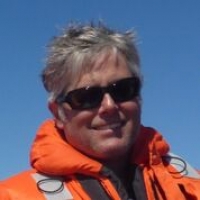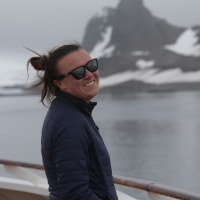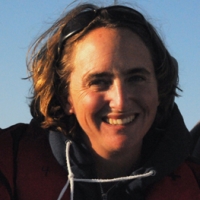By Lisa Hildebrand, MSc student, OSU Department of Fisheries & Wildlife, Geospatial Ecology of Marine Megafauna Lab
The GEMM Lab is back from Barcelona after attending the World Marine Mammal Conference last week and it sure was a week to remember! Not only did every GEMM member present some aspect of their research at the conference (either as a poster, speed or full-length talk) but some of us also attended workshops, scheduled meetings with collaborators, new & old, and we certainly all learned a lot of new information about what is going on in marine mammalogy across the globe. Having had a few days now to reflect upon the intense four days spent at the conference, we want to highlight the talks that we each personally thought were some of the most interesting and exciting.

“Double Drone Drama” was the alliterative title of Héloïse Frouin-Mouy‘s talk about using two drones to collect simultaneous visual and underwater acoustic behavioral data of gray whales in Baja California, Mexico. While there were many talks during the week that discussed incorporating drones, also known as unmanned aerial vehicles (UAVs), into marine mammal research, this project was potentially the only one that discussed using two simultaneously. One drone collected visual aerial observations while the other obtained close-range passive acoustic measurements with an underwater recording hydrophone to better understand the behavioral contexts of call generation. Froiun-Mouy and her team detected call-type-specific source levels relative to behavior state through this dual-approach. For example, they were able to estimate the acoustic source levels of bubble-blasts produced by gray whales, and the double drone action recorded a variety of calls. Using two or more UAVs can provide a more integrated snapshot into the animal vocalization context, and it will be interesting to see whether this method is applied elsewhere on a variety of whale species.


Tara Sayuri Whitty discussed her doctoral research focused on understanding the mental models of local, artisanal fishing communities at the heart of the vaquita conservation efforts. The vaquita has experienced rapid population declines due primarily to bycatch in gillnet fisheries from legal local gillnet fisheries and the illegal totoaba fishery. With the sole intent of preventing bycatch, gillnets were banned for legal practice, but the illegal totoaba fishery continued, as did vaquita bycatch. Whitty conducted interviews to understand the mental models and perceptions of local fishing communities towards officials and conservationists regarding the gillnet band. She discovered that these conservation efforts have not only failed to prevent vaquita bycatch, but they have now pitted conservationists against local communities because an important aspect of their livelihoods is now banned. This misstep and lack of trust with the community now threatens future conservation and recovery progress for the vaquita and highlights the need to collaborate and engage with local communities early and often when such efforts are so closely tied to human well-being.

Pauline Goulet, a PhD student in the Sea Mammal Research Unit at the University of St. Andrews, presented findings obtained from a novel sonar tag deployed on southern elephant seals (SES) in the Kerguelen Islands and Peninsula Valdes. Gaining insight into predator-prey interactions is critical to understanding the ecology of marine mammals as they live in dynamic and vast environments where prey is patchy. Collecting in-situ prey information is difficult, and in some cases impossible, due to the remote locations where marine mammals forage and it is not being feasible to follow individuals around continuously to collect prey samples at every foraging event. In an attempt to overcome this universal challenge to marine mammal research, Goulet and her collaborators decided to mimic the experts in prey detection and visualization from a distance in the marine environment – echolocating odontocetes. By equipping conventional DTAGs with a 1.5 MHz single beam sonar with a 6 m detection range, Goulet was able to identify whether SES were pursuing individual fish or large schools of fish. Additionally, by also analyzing the accelerometer data, she could document whether prey capture attempts were successful or not, and link these results to the body condition of individual SES (inferred from the horizontal distance an individual traveled during drift dives, whereby a longer horizontal distance in the same period of time suggested that the individual had gained weight and was now heavier). It was ingenious to see researchers utilize a biological trait that evolved millions of years ago in certain marine mammal predators to better understand the ecology of another marine mammal predator.
A trio of talks given by Kristi Fazioli, Valeria Paz, and Shauna McBride-Kebert, in the ‘Habitat and Distribution II’ session, discussed responses of coastal bottlenose dolphins to hurricanes in the Gulf of Mexico (GoM). Besides continuing to be an area of interest in conservation after the Deepwater Horizon oil spill, the GoM frequently experiences hurricanes and other strong storm systems that cause extensive flooding events annually. Hence, dolphins along the GoM coast experience a large outflow of freshwater after severe precipitation, leading to low salinity events. Both Fazioli and Paz hypothesized that these changes in environmental conditions can create health problems to the dolphins.

Fazioli investigated encounter rates and skin conditions of bottlenose dolphins after Hurricane Harvey. She found that, in 2017, the encounter rates in her study area decreased, while skin lesions increased (Christina Toms, unpublished work, expected Spring 2020). Skin lesions are known to occur at higher rates after exposure to freshwater and even though they persist for some time, they eventually do heal. After less than two years, preliminary data suggest that these dolphins have returned to their original distributions in the study area. Paz’s study in Shark Bay Estuary examined different environmental drivers of dolphin distribution following Hurricane Irma. She found that dissolved oxygen, salinity, and temperature were the primary dynamic, environmental drivers of distribution following a major hurricane. Lastly, McBride’s species distribution models of bottlenose dolphins in response to severe flooding concluded that depth, slope, latitude, longitude, season, and dissolved oxygen all contributed in different percentages to distribution.

Marta Guerra presented findings from her PhD research at the University of Otago in New Zealand on the ecology and distribution of sperm whales in New Zealand. Kaikoura canyon is a region utilized by sperm whales for foraging, and Marta’s research highlighted marked differences in their distribution between the summer and winter, likely reflective of the sperm whales switching their target prey items seasonally. In the middle of their data collection period, a very intense earthquake struck the region in 2016, causing a canyon-flushing event that altered the canyon ecosystem. The sperm whales responded to this extreme event by altering their distribution away from the areas most affected by the earthquake, demonstrating that these marine predators respond to environmental shifts in the ecosystem they depend on at multiple scales.

On the final day of the conference, David Wiley gave a talk entitled “First documentation of coordinated bottom-feeding by humpback whales”. Using footage from tags containing a suite of sensors and video cameras, Wiley and colleagues observed humpback whales feeding on sand lace in the Stellwagen Bank National Marine Sanctuary. Sand lace are a species of fish that frequently burrow in the sand in an attempt to avoid capture by predators looking for their next meal. Humpback whales in the area have been observed with lacerations and scars along their mouths, originally leading to the hypothesis that whales were bottom-feeding. However, it was never known whether whales compete or cooperate when exploiting this resource and what the actual mechanics of this feeding behavior look like. The tag data revealed that groups of 3-4 individuals work together to approach the seafloor in a star-shape formation and when they get close enough, the sand lace emerge from the sand (probably an escape response to the approaching vibrations created by large whales) only to be engulfed by the humpbacks who are poised directly above them with wide-open mouths. Not only did the video footage reveal that individuals are so close together that their rostrums are almost touching, but Wiley and team were able to determine that whales perform their behavior usually within the same group of 3-4 individuals and that the orientation of each individual within the star-formation remains the same almost every time. This talk was so enjoyable because it was a reminder of how little we still know about marine mammals and provided a moment of audible awe and surprise throughout the room.








